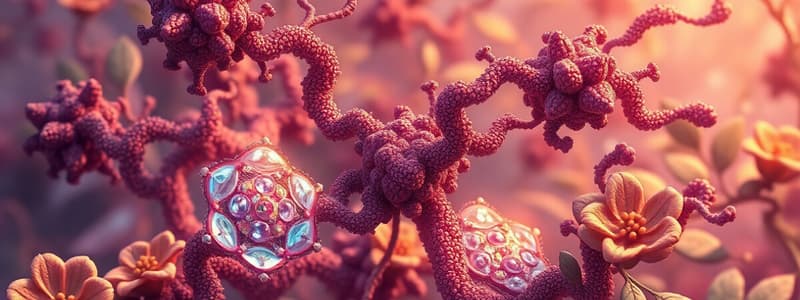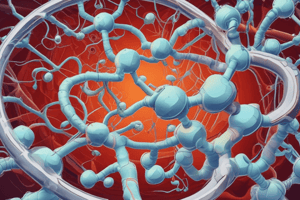Podcast
Questions and Answers
What defines the specificity of enzymes?
What defines the specificity of enzymes?
- They are highly specific in the reaction catalyzed and choice of substrates. (correct)
- They catalyze multiple reactions simultaneously.
- They produce by-products in significant amounts.
- They can work with any type of substrate equally.
Which enzyme is known for cutting the peptide bond on the carboxyl side of basic amino acids?
Which enzyme is known for cutting the peptide bond on the carboxyl side of basic amino acids?
- Trypsin (correct)
- Elastase
- Aminopeptidase
- Chymotrypsin
What are isoenzymes?
What are isoenzymes?
- Inactive precursors of enzymes.
- Multiple forms of an enzyme catalyzing the same reaction. (correct)
- Multiple forms of an enzyme that catalyze different reactions.
- Active forms of enzymes only.
What role do enzymes play in the transition state of a reaction?
What role do enzymes play in the transition state of a reaction?
What describes proenzymes?
What describes proenzymes?
Which of the following statements is true concerning enzymes and free energy?
Which of the following statements is true concerning enzymes and free energy?
In which model is the enzyme's active site perfectly shaped to fit the substrate?
In which model is the enzyme's active site perfectly shaped to fit the substrate?
Which type of enzyme often functions as a multi-subunit structure?
Which type of enzyme often functions as a multi-subunit structure?
Which of the following is NOT a factor necessary for enzyme catalysis?
Which of the following is NOT a factor necessary for enzyme catalysis?
What is the difference in free energy known as when referring to the transition state?
What is the difference in free energy known as when referring to the transition state?
What is the effect of pH on enzyme activity?
What is the effect of pH on enzyme activity?
At what temperature do human enzymes peak in activity?
At what temperature do human enzymes peak in activity?
What happens to enzymes if the pH is significantly deviated from their optimal level?
What happens to enzymes if the pH is significantly deviated from their optimal level?
How does temperature influence enzyme activity?
How does temperature influence enzyme activity?
What would likely happen to enzyme activity if body temperature rises significantly above 98.6 degrees Fahrenheit?
What would likely happen to enzyme activity if body temperature rises significantly above 98.6 degrees Fahrenheit?
What is a characteristic feature of allosteric enzymes?
What is a characteristic feature of allosteric enzymes?
How do activators affect allosteric enzymes?
How do activators affect allosteric enzymes?
Which statement about feedback inhibition is true?
Which statement about feedback inhibition is true?
What shape does the velocity vs. substrate concentration curve for allosteric enzymes typically exhibit?
What shape does the velocity vs. substrate concentration curve for allosteric enzymes typically exhibit?
What is an effect of covalent modification on enzymes?
What is an effect of covalent modification on enzymes?
How does physostigmine alleviate the symptoms related to neurotransmitter signaling defects?
How does physostigmine alleviate the symptoms related to neurotransmitter signaling defects?
What best describes the effect of aspirin on COX enzymes?
What best describes the effect of aspirin on COX enzymes?
What is the mechanism of action of methotrexate on dihydrofolate reductase (DHFR)?
What is the mechanism of action of methotrexate on dihydrofolate reductase (DHFR)?
What mechanism do virtually all enzymes use to facilitate reactions?
What mechanism do virtually all enzymes use to facilitate reactions?
What is the expected effect of methotrexate on the synthesis of tetrahydrofolate?
What is the expected effect of methotrexate on the synthesis of tetrahydrofolate?
What happens to enzyme activity with a further increase in temperature after an optimal point?
What happens to enzyme activity with a further increase in temperature after an optimal point?
How does the rate of an enzymatic reaction change with a 10-degree increase in temperature?
How does the rate of an enzymatic reaction change with a 10-degree increase in temperature?
Which factors influence the rate of an enzymatic reaction?
Which factors influence the rate of an enzymatic reaction?
What effect does increasing substrate concentration have on the initial rate of an enzymatic reaction?
What effect does increasing substrate concentration have on the initial rate of an enzymatic reaction?
What is enzyme kinetics primarily concerned with?
What is enzyme kinetics primarily concerned with?
If the temperature is kept constant, what remains the most influential aspect on reaction rate?
If the temperature is kept constant, what remains the most influential aspect on reaction rate?
What is the consequence of enzyme denaturation?
What is the consequence of enzyme denaturation?
What does a plot of substrate concentration versus enzyme activity typically show?
What does a plot of substrate concentration versus enzyme activity typically show?
Flashcards
Enzyme Specificity
Enzyme Specificity
Enzymes are highly specific catalysts. They catalyze only one particular reaction and only act on specific reactants called substrates.
Isoenzyme
Isoenzyme
Multiple forms of an enzyme that catalyze the same reaction. They differ in their amino acid sequence and have different kinetic properties.
Allosteric Enzyme
Allosteric Enzyme
Multi-subunit enzymes with identical or different polypeptide chains. They have regulatory sites distinct from the active site where allosteric effectors bind, affecting activity.
Proenzyme
Proenzyme
Signup and view all the flashcards
Enzyme Efficiency
Enzyme Efficiency
Signup and view all the flashcards
Transition State
Transition State
Signup and view all the flashcards
How Enzymes Work
How Enzymes Work
Signup and view all the flashcards
Enzymes and Energy
Enzymes and Energy
Signup and view all the flashcards
Lock and Key Model
Lock and Key Model
Signup and view all the flashcards
Induced Fit Model
Induced Fit Model
Signup and view all the flashcards
What is pH?
What is pH?
Signup and view all the flashcards
How does pH affect enzyme activity?
How does pH affect enzyme activity?
Signup and view all the flashcards
Can extreme pH damage enzymes?
Can extreme pH damage enzymes?
Signup and view all the flashcards
How does temperature affect enzyme activity?
How does temperature affect enzyme activity?
Signup and view all the flashcards
At what temperature are human enzymes most active?
At what temperature are human enzymes most active?
Signup and view all the flashcards
What are allosteric enzymes?
What are allosteric enzymes?
Signup and view all the flashcards
What are allosteric effectors?
What are allosteric effectors?
Signup and view all the flashcards
What do allosteric activators do?
What do allosteric activators do?
Signup and view all the flashcards
What do allosteric inhibitors do?
What do allosteric inhibitors do?
Signup and view all the flashcards
Why do allosteric enzymes show a sigmoidal curve?
Why do allosteric enzymes show a sigmoidal curve?
Signup and view all the flashcards
Enzyme activity
Enzyme activity
Signup and view all the flashcards
Enzyme denaturation
Enzyme denaturation
Signup and view all the flashcards
Temperature optima
Temperature optima
Signup and view all the flashcards
Michaelis constant (Km)
Michaelis constant (Km)
Signup and view all the flashcards
Substrate saturation
Substrate saturation
Signup and view all the flashcards
Michaelis-Menten plot
Michaelis-Menten plot
Signup and view all the flashcards
How does physostigmine alleviate symptoms?
How does physostigmine alleviate symptoms?
Signup and view all the flashcards
What type of inhibitor is aspirin?
What type of inhibitor is aspirin?
Signup and view all the flashcards
How does methotrexate inhibit DHFR?
How does methotrexate inhibit DHFR?
Signup and view all the flashcards
How do enzymes catalyze reactions?
How do enzymes catalyze reactions?
Signup and view all the flashcards
What is enzyme specificity?
What is enzyme specificity?
Signup and view all the flashcards
Study Notes
Introduction to Enzymes
- Enzymes are protein catalysts that increase the rate of reactions without being altered in the process.
- All enzymes are proteins, with a notable exception being ribozymes, which are catalytic RNA molecules involved in RNA processing.
Learning Objectives
- Explain how substrates are enzymatically transformed into products, including transition states and activation energy. Use energy diagrams to illustrate the process.
- Compare and contrast the lock-and-key and induced-fit models of enzyme-substrate interactions.
- Differentiate between cofactors, coenzymes, and isozymes.
- Describe how functional groups, amino acid side chains, coenzymes, and metal ions contribute to enzymatic reactions.
- Describe how factors like pH, temperature, and enzyme/substrate concentrations affect reaction rates.
- Compare and contrast Michaelis-Menten and Lineweaver-Burk plots, including the roles of Vmax and Km in enzyme inhibition.
- Explain how different factors impact enzyme activity. Explain KD vs. Km comparisons. Compare different methods of enzyme regulation
- Explain the importance of regulatory enzymes, including various methods for regulation (feedback inhibition, allosteric regulation, covalent modification, and hormonal regulation), in metabolic pathways.
- Compare the catalytic mechanisms of allosteric and Michaelis-Menten enzymes.
Enzyme Substrates and Transition States
- The combination of an enzyme and its substrate forms an enzyme-substrate complex.
- The rate of an enzyme-catalyzed reaction is directly proportional to the amount of enzyme-substrate complex.
- The transition state is a highly unstable intermediate between substrate and product.
- Enzymes stabilize transition states, lowering activation energy, and thus increasing the reaction rate.
Catalytic Efficiency
- Uncatalyzed reactions are slow, requiring high activation energy.
- Enzymes lower the free energy of activation, increasing the reaction rate.
- Enzymes do not alter the free energy of reactants/products.
- Enzymes are not altered during the reaction.
Free Energy of Activation
- The free energy of activation is the difference in free energy between the transition state and the reactants.
- Enzymes increase the rate of exergonic reactions by lowering the activation energy.
Types of Enzyme-Substrate Interactions
- "Lock and Key" model: substrate fits precisely into the active site.
- "Induced Fit" model: enzyme active site changes shape to fit the substrate.
Factors for Enzyme Catalysis
- Active sites: pockets on the enzyme with specific shapes and chemical properties.
- Cofactors: non-protein molecules. Can be metal ions or coenzymes.
- Coenzymes: organic molecules derived from vitamins.
- Prosthetic groups: tightly bound coenzymes.
- Compartmentalization: enzymes are localized in specific organelles, isolating reaction substrates.
- Specificity: enzymes are highly specific for their substrates and reactions.
Reaction in the Active Site
- Enzymes contain an active site where substrates bind and reactions occur.
- The active site is specific for the substrate, creating a three-dimensional structure matching the substrate.
- Amino acids in the active site form weak bonds with the substrate, which helps catalyze the reaction.
- A transition complex (intermediate between substrate and product) is created.
- Products are released, and the enzyme returns to its original state.
Cofactors
- Inorganic cofactors: include metal ions (e.g., Mg2+, Fe2+, Zn2+).
- Organic cofactors (coenzymes): derived from vitamins (e.g., NAD+, FAD, Coenzyme A).
- Prosthetic groups: tightly bound to the enzyme.
- Co-substrates: temporarily bind to the enzyme.
Enzyme Kinetics
- Kinetics measures the speed of a reaction.
- The rate of an enzyme-catalyzed reaction is affected by pH, temperature, enzyme concentration, and substrate concentration.
- Michaelis-Menten equation describes the relationship between reaction rates and substrate concentration. Vmax and Km are important constants.
KM and KD
- KM: Michaelis-Menten constant; numerically equivalent to substrate concentration when reaction velocity equals half Vmax; measures the impact of substrate concentration on reaction speeds, and can be used as an indirect measure of affinity
- KD: Dissociation constant: thermodynamic constant, measures the affinity of ligand to binding site; concentration at which 50% ligand dissociates from the enzyme; doesn't reflect reaction speed.
Important Information from Michaelis-Menten Kinetics
- Comparison of Isoenzymes (e.g., hexokinase and glucokinase)
- The role of the enzymes in transferring a phosphate from ATP to glucose
Hexokinase
- Found in all cells, but little in the liver
- Has broad specificity (glucose or fructose)
- High affinity, so low substrate concentration (e.g., low blood glucose) is enough to get a reaction.
Glucokinase
- Found primarily in liver and pancreatic cells.
- Only acts on glucose
- Low affinity, requiring higher substrate concentrations to activate.
- Essential to remove excess glucose from the bloodstream after eating (high blood glucose).
Enzyme Regulation
- Regulation by other molecules that either promote or inhibit activity.
- Activators, inhibitors. Diverse pathways and molecules that block, promote, or otherwise affect enzyme function.
- Examples:
- Substrate availability: The velocity of reaction changes with substrate availability.
- Product inhibition: Product inhibition can impact Vmax and/or Km
- Allosteric control: allosteric effectors (or activators/inhibitors) binds at a site other than the active site; these effectors can change the enzyme's conformation
- Covalent modification: another enzyme adds a phosphate group (or otherwise covalently alters the enzyme); e.g., phosphorylating/dephosphorylating a protein
- Induction/repression: alters the amount of an enzyme, typically via changes to gene expression to produce an enzyme
Regulatory Enzymes
- Catalyze irreversible reactions and are at committed steps in metabolic pathways
- Important for precisely controlling metabolic flux.
- Examples: Phosphofructokinase (a key enzyme in glycolysis)
Enzyme Inhibition
- Types of inhibition include:
- Competitive: inhibitor resembles substrate, binding reversibly at the active site.
- Noncompetitive: inhibitor binds to an enzyme site different from the active site (changing the conformation), altering Vmax, but not Km.
- Uncompetitive: inhibitor binds only to the enzyme-substrate complex, altering both Km and Vmax.
- Irreversible: inhibitor binds covalently to the enzyme (often at the active site). The inhibitor permanently inactivates the enzyme
Irreversible (Suicide) Inhibitors
- Bind covalently to the enzyme, permanently inactivating it
- Useful in new drugs and therapies
Enzyme Examples
- Use of inhibitors (for example lovastatin, aspirin, and penicillin)
- Regulation of enzymes such as HMG-CoA reductase, cyclooxygenase(COX), dihydrofolate reductase (DHFR)
Nutrition and Enzymes
- Endogenous enzymes (produced by the body) include those for digestion (proteases, lipases, amylases), and autolytic enzymes.
- Exogenous enzymes (from other sources) are often inactivated by high temperatures (e.g., cooked foods vs. raw foods), and are found in raw food sources.
Study Questions
- Clinical scenarios and examples of how drugs affect enzyme functioning
Studying That Suits You
Use AI to generate personalized quizzes and flashcards to suit your learning preferences.




